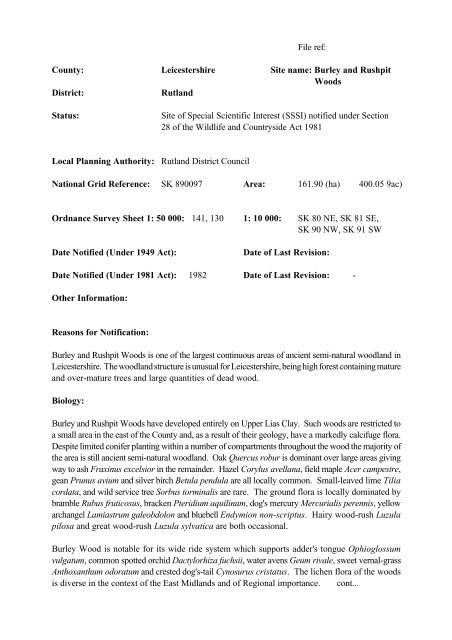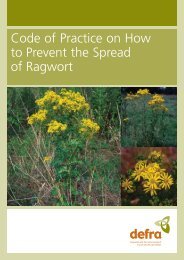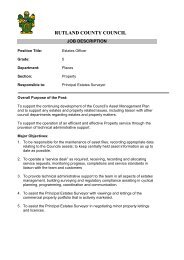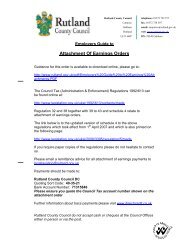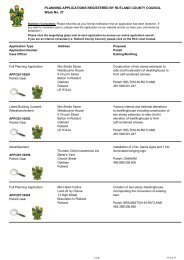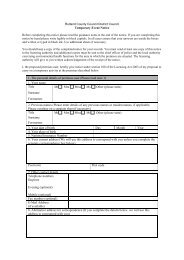Appendix 2 - Burley Woods SSSI - Rutland County Council
Appendix 2 - Burley Woods SSSI - Rutland County Council
Appendix 2 - Burley Woods SSSI - Rutland County Council
You also want an ePaper? Increase the reach of your titles
YUMPU automatically turns print PDFs into web optimized ePapers that Google loves.
File ref:<br />
<strong>County</strong>: Leicestershire Site name: <strong>Burley</strong> and Rushpit<br />
<strong>Woods</strong><br />
District: <strong>Rutland</strong><br />
Status: Site of Special Scientific Interest (<strong>SSSI</strong>) notified under Section<br />
28 of the Wildlife and Countryside Act 1981<br />
Local Planning Authority: <strong>Rutland</strong> District <strong>Council</strong><br />
National Grid Reference: SK 890097 Area: 161.90 (ha) 400.05 9ac)<br />
Ordnance Survey Sheet 1: 50 000: 141, 130 1: 10 000: SK 80 NE, SK 81 SE,<br />
SK 90 NW, SK 91 SW<br />
Date Notified (Under 1949 Act): Date of Last Revision:<br />
Date Notified (Under 1981 Act): 1982 Date of Last Revision: -<br />
Other Information:<br />
Reasons for Notification:<br />
<strong>Burley</strong> and Rushpit <strong>Woods</strong> is one of the largest continuous areas of ancient semi-natural woodland in<br />
Leicestershire. The woodland structure is unusual for Leicestershire, being high forest containing mature<br />
and over-mature trees and large quantities of dead wood.<br />
Biology:<br />
<strong>Burley</strong> and Rushpit <strong>Woods</strong> have developed entirely on Upper Lias Clay. Such woods are restricted to<br />
a small area in the east of the <strong>County</strong> and, as a result of their geology, have a markedly calcifuge flora.<br />
Despite limited conifer planting within a number of compartments throughout the wood the majority of<br />
the area is still ancient semi-natural woodland. Oak Quercus robur is dominant over large areas giving<br />
way to ash Fraxinus excelsior in the remainder. Hazel Corylus avellana, field maple Acer campestre,<br />
gean Prunus avium and silver birch Betula pendula are all locally common. Small-leaved lime Tilia<br />
cordata, and wild service tree Sorbus torminalis are rare. The ground flora is locally dominated by<br />
bramble Rubus fruticosus, bracken Pteridium aquilinum, dog's mercury Mercurialis perennis, yellow<br />
archangel Lamiastrum galeobdolon and bluebell Endymion non-scriptus. Hairy wood-rush Luzula<br />
pilosa and great wood-rush Luzula sylvatica are both occasional.<br />
<strong>Burley</strong> Wood is notable for its wide ride system which supports adder's tongue Ophioglossum<br />
vulgatum, common spotted orchid Dactylorhiza fuchsii, water avens Geum rivale, sweet vernal-grass<br />
Anthoxanthum odoratum and crested dog's-tail Cynosurus cristatus. The lichen flora of the woods<br />
is diverse in the context of the East Midlands and of Regional importance. cont...
<strong>Burley</strong> and Rushpit <strong>Woods</strong> (cont...)<br />
The woods have a rich dead-wood invertebrate fauna which includes one Red Data Book species,<br />
Isochnomera cinerascens, and five nationally scarce species Xylota xanthocnema, Nossidium<br />
pillosellum, Ctesias serra, Ericmus brevicornis and Prionychus ater. Together, these saproxylic<br />
species indicate a long continuity of mature timber and dead-wood habitat. The woodland breeding bird<br />
community is one of the richest within Leicestershire as a result of the diversity of habitats present and<br />
the large size of the woods. Additional interest is provided by a number of small ponds and woodland<br />
streams.


